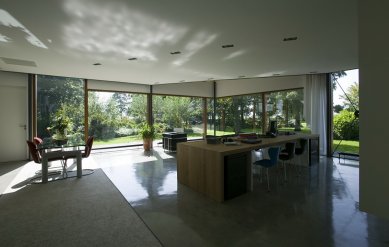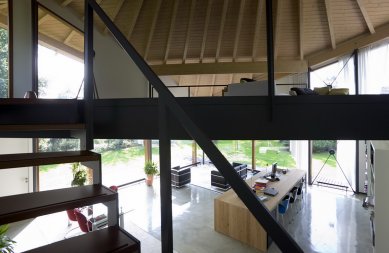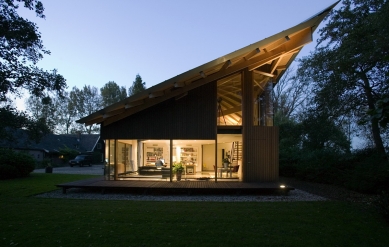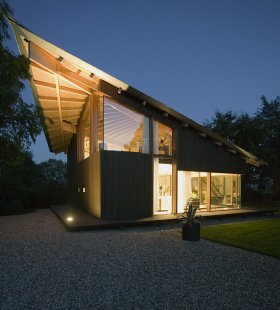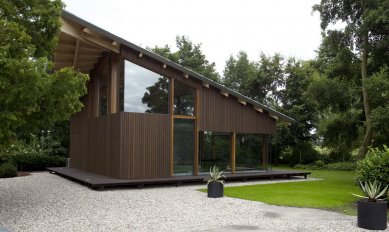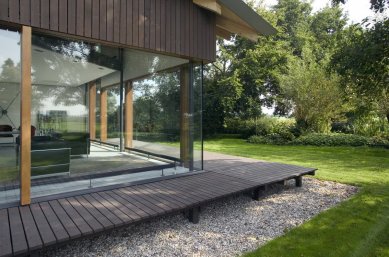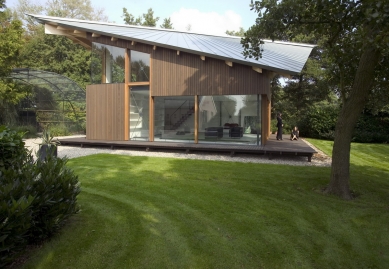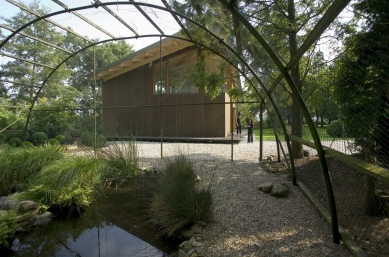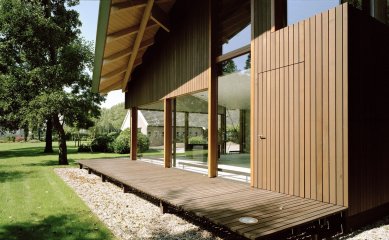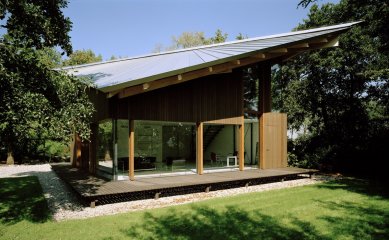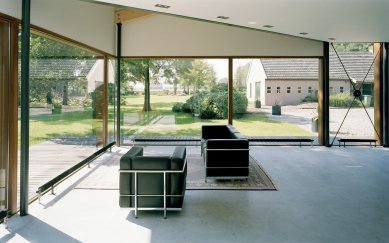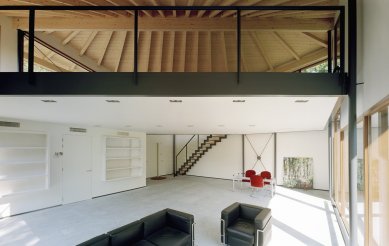
Paradise for two
Pavilion and house

team: Maurice Nio, Arek Seredyn
The grasses and marshes of the Bosthol Nature Reserve are home to unique plants (wild orchids, cotton, hornworts, marsh rubber plants, rare wetland plants) and birds (hen harriers, marsh harriers, cormorants, bitterns, great crested grebes, colorful spoonbills). This reserve is hidden in an oasis in the middle of Ranstad. In the protective zone of the Boston Reserve, no new construction is allowed, and there are significant restrictions on new buildings and the renovation of existing structures in the adjacent areas of De Ronde Venen. Therefore, much has remained unchanged here. It is an art to create something new here that meets the needs and desires of the residents while remaining in harmony with nature. (The immediate surroundings of Bosthol were declared a natural development area in 2000. The result is the release of agricultural land and the expansion of wetland areas.)
Right where the simple peat plains meet the unpredictable landscape of Bosthol, there is a garden whose inner world is hidden from the surroundings. Just as confidently as Bosthol itself, the garden reveals only its green edges. Two buildings, almost invisible from the outside, a farm and an outbuilding, await renovation…
The goal of the renovation was, in the spirit of the garden that has been cultivated almost to the heavenly, to further deepen the unexpected atmosphere of this place.
The foundation of the design consists of two distinct zinc roofs under which varied spaces have emerged, seamlessly and harmoniously intertwined and connected.
The first part is complete. The outbuilding has been converted into a pavilion. The zinc roof was boldly placed diagonally over the square wooden structure. The rafters fan out, as if trying to emulate the patterns of the nearby wetlands of Vinkeveense Plassen, and the dark wooden walkway is raised above the ground level, creating the impression that the pavilion is almost hovering above the garden. The appearance of the pavilion is entirely new. Perhaps unexpected, but at the same time as natural and elegant as a cormorant in Bosthol.
The Netherlands is not a country you would go to explore the wonders of nature. To the probing question of whether they even have any forests, some will seriously reply that it's enough to take a train and travel half an hour into the center of the Netherlands, where there is a huge forest. The Bosthol Nature Reserve is an exceptional and cherished part of the natural wealth of the Netherlands. Any intervention, new construction, and renovation truly attract great attention and require the most refined and harmonious solutions. Therefore, architects (usually using the most modern materials that change color, sparkle in the sunlight, or react to heat) in this case resorted to tried-and-true natural materials. The primary building material is wood. In the tectonics of the pavilion, one cannot overlook the inspiration in the beauty and simplicity of Japanese architecture. But inspiration also came from the raw nature of Australian timber constructions in the prairie. The advancement, innate decorativeness, yet simplicity and naturalness of the details of Japanese wooden architecture are rarely comparable today. Even the smallest details received enormous care, illustrated in hundreds of technical drawings. Many details were simulated and tested on a 3D model in a computer. Perhaps because of this exaggerated care, the pavilion partially lost the spirit of Australian rawness and "roughness" and may even seem overly polished. However, this does not have to be negative. The pavilion serves as a representative office for the client, and when you welcome guests, you do not dress like a "bushman."
Arek Seredyn and Maurice Nio tried to learn, refine, and surpass the know-how of these masters. In the Nio architecten library, you would find more than one book on Japanese and Australian architecture and its masters (Shigeru Ban and others). Only after you have mastered the language perfectly can you start writing poetry. And architects should build poetry, not write it.
The grasses and marshes of the Bosthol Nature Reserve are home to unique plants (wild orchids, cotton, hornworts, marsh rubber plants, rare wetland plants) and birds (hen harriers, marsh harriers, cormorants, bitterns, great crested grebes, colorful spoonbills). This reserve is hidden in an oasis in the middle of Ranstad. In the protective zone of the Boston Reserve, no new construction is allowed, and there are significant restrictions on new buildings and the renovation of existing structures in the adjacent areas of De Ronde Venen. Therefore, much has remained unchanged here. It is an art to create something new here that meets the needs and desires of the residents while remaining in harmony with nature. (The immediate surroundings of Bosthol were declared a natural development area in 2000. The result is the release of agricultural land and the expansion of wetland areas.)
Right where the simple peat plains meet the unpredictable landscape of Bosthol, there is a garden whose inner world is hidden from the surroundings. Just as confidently as Bosthol itself, the garden reveals only its green edges. Two buildings, almost invisible from the outside, a farm and an outbuilding, await renovation…
The goal of the renovation was, in the spirit of the garden that has been cultivated almost to the heavenly, to further deepen the unexpected atmosphere of this place.
The foundation of the design consists of two distinct zinc roofs under which varied spaces have emerged, seamlessly and harmoniously intertwined and connected.
The first part is complete. The outbuilding has been converted into a pavilion. The zinc roof was boldly placed diagonally over the square wooden structure. The rafters fan out, as if trying to emulate the patterns of the nearby wetlands of Vinkeveense Plassen, and the dark wooden walkway is raised above the ground level, creating the impression that the pavilion is almost hovering above the garden. The appearance of the pavilion is entirely new. Perhaps unexpected, but at the same time as natural and elegant as a cormorant in Bosthol.
author's report
The Netherlands is not a country you would go to explore the wonders of nature. To the probing question of whether they even have any forests, some will seriously reply that it's enough to take a train and travel half an hour into the center of the Netherlands, where there is a huge forest. The Bosthol Nature Reserve is an exceptional and cherished part of the natural wealth of the Netherlands. Any intervention, new construction, and renovation truly attract great attention and require the most refined and harmonious solutions. Therefore, architects (usually using the most modern materials that change color, sparkle in the sunlight, or react to heat) in this case resorted to tried-and-true natural materials. The primary building material is wood. In the tectonics of the pavilion, one cannot overlook the inspiration in the beauty and simplicity of Japanese architecture. But inspiration also came from the raw nature of Australian timber constructions in the prairie. The advancement, innate decorativeness, yet simplicity and naturalness of the details of Japanese wooden architecture are rarely comparable today. Even the smallest details received enormous care, illustrated in hundreds of technical drawings. Many details were simulated and tested on a 3D model in a computer. Perhaps because of this exaggerated care, the pavilion partially lost the spirit of Australian rawness and "roughness" and may even seem overly polished. However, this does not have to be negative. The pavilion serves as a representative office for the client, and when you welcome guests, you do not dress like a "bushman."
Arek Seredyn and Maurice Nio tried to learn, refine, and surpass the know-how of these masters. In the Nio architecten library, you would find more than one book on Japanese and Australian architecture and its masters (Shigeru Ban and others). Only after you have mastered the language perfectly can you start writing poetry. And architects should build poetry, not write it.
Radek Brunecký
The English translation is powered by AI tool. Switch to Czech to view the original text source.
2 comments
add comment
Subject
Author
Date
nádhera
Hynek Rožanský
19.03.07 08:50
Krásná zahrada
Pavel Fejt
13.01.09 03:46
show all comments


